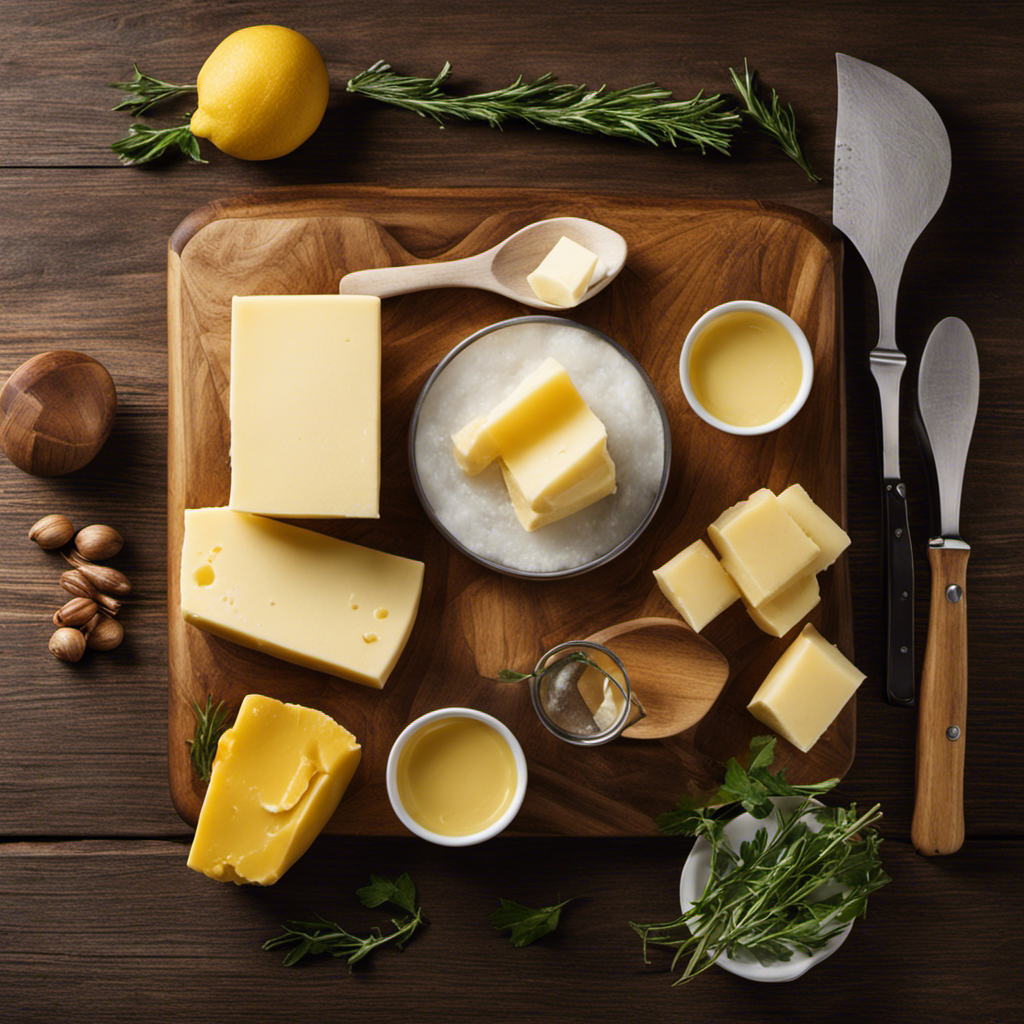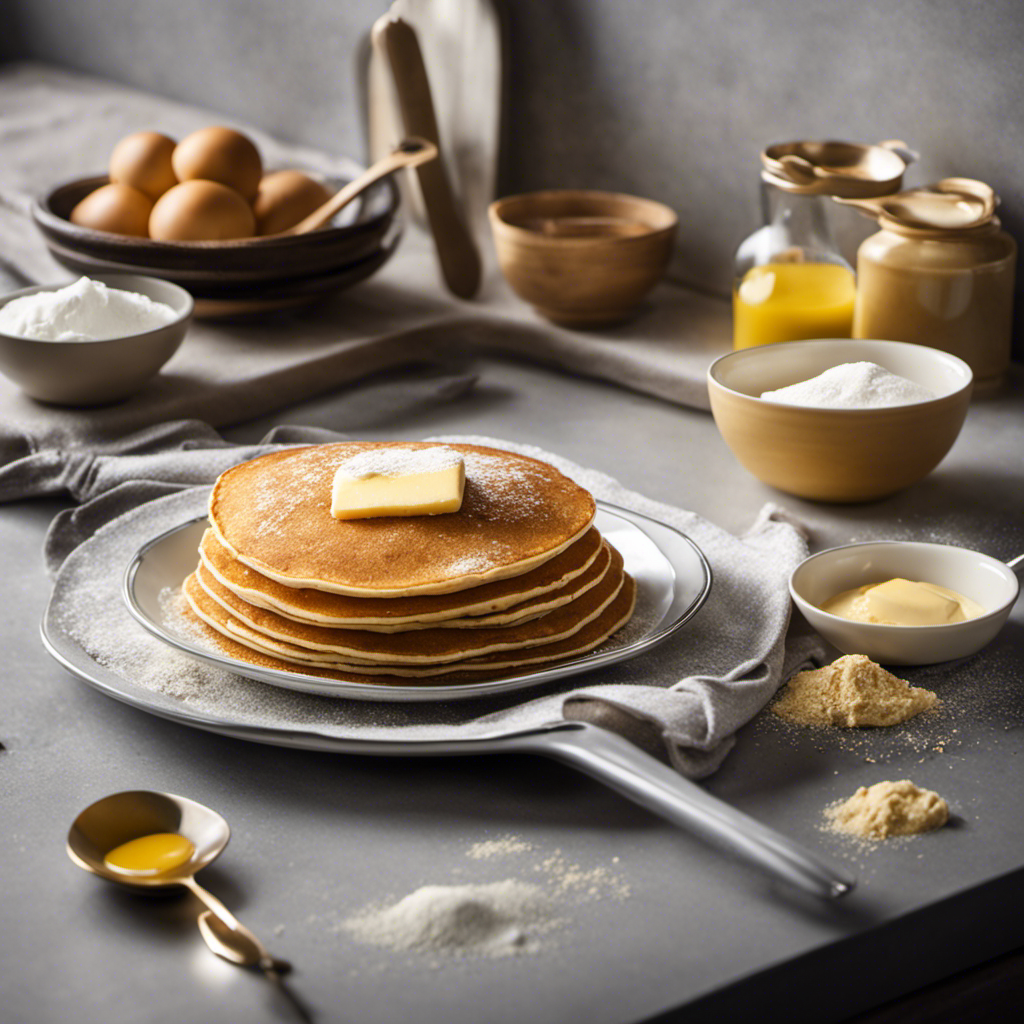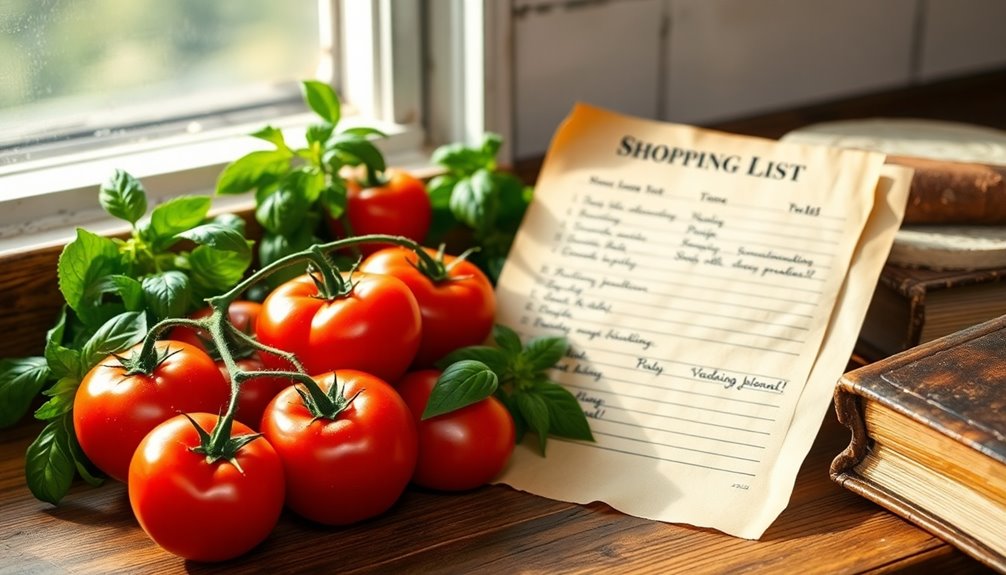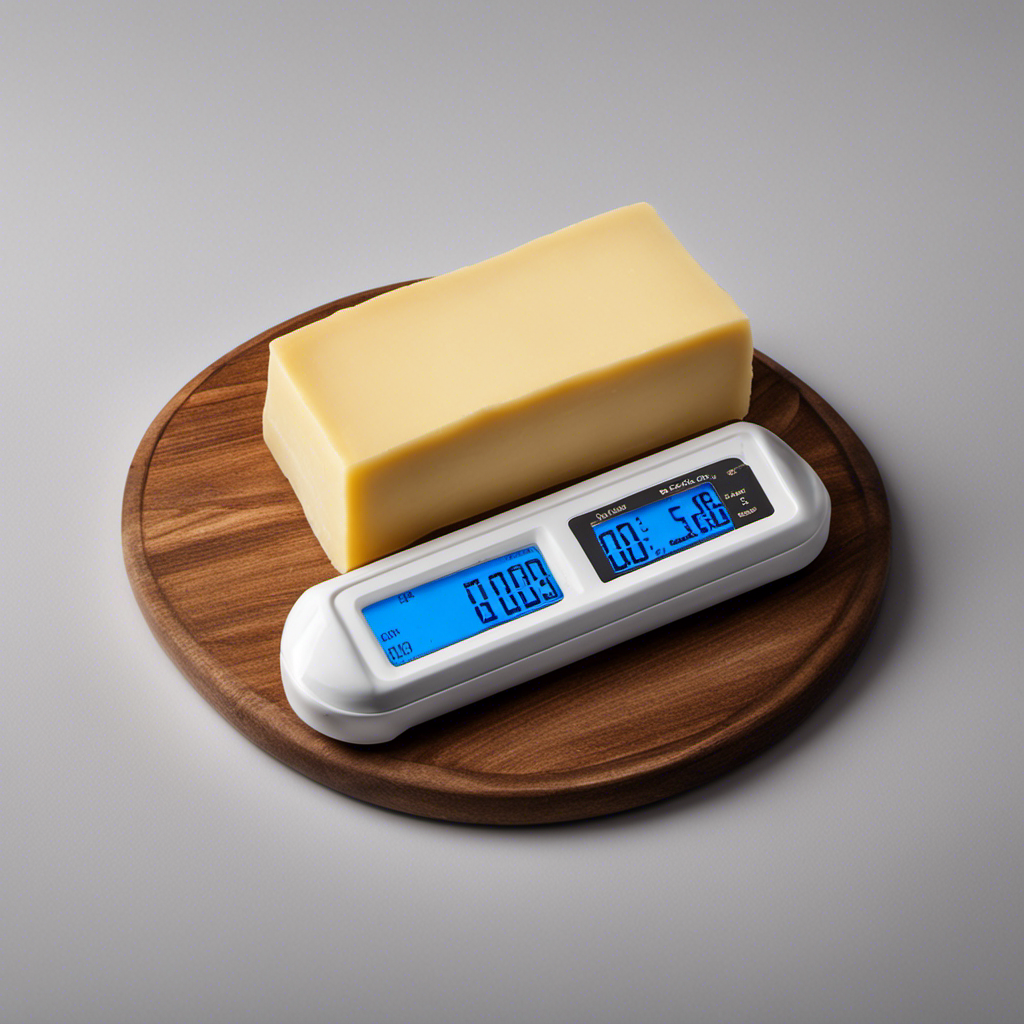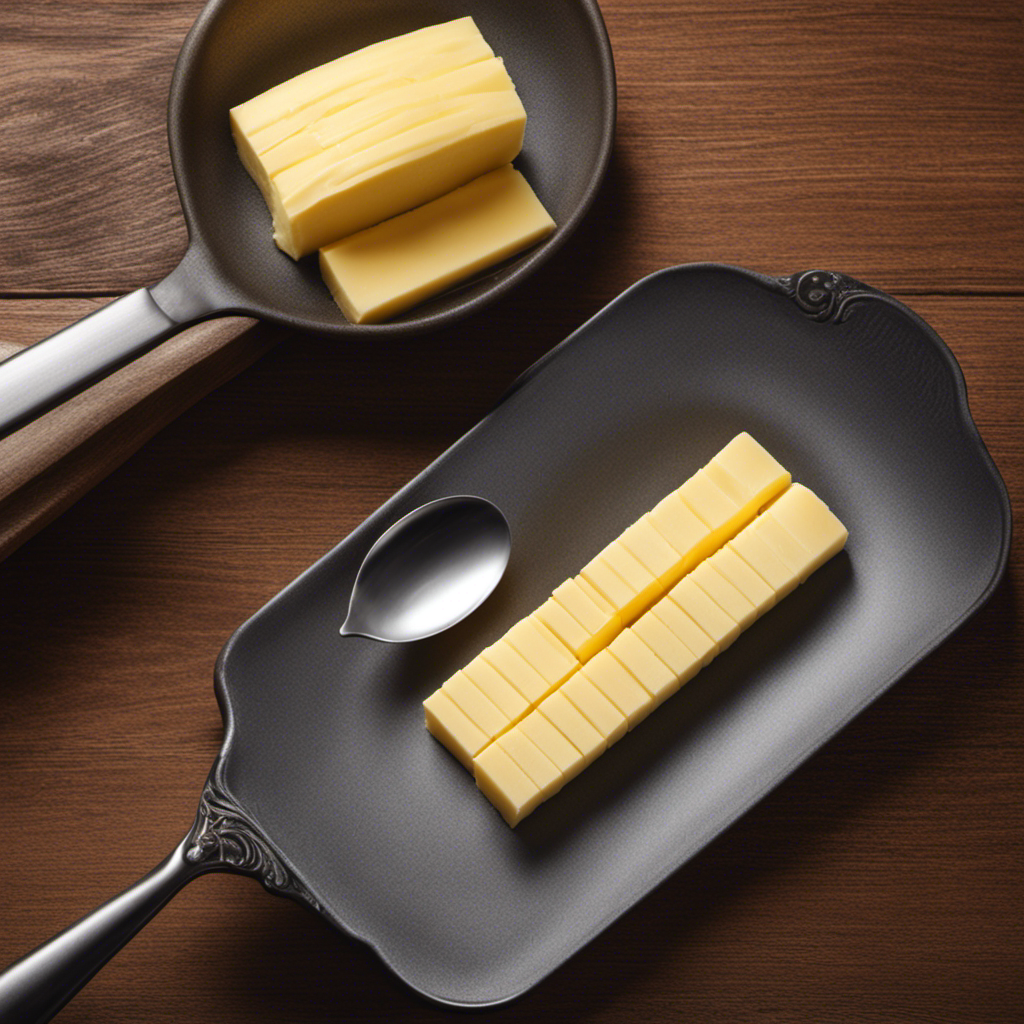I’ve always been curious about the mysterious connection between a stick of butter and its equivalent measurement in cups. It’s like solving a culinary puzzle!
Well, fret no more, because in this article, I’ll dive deep into the world of butter measurements and unravel the secrets behind converting one stick of butter to cups.
So, if you’re ready to solve this buttery enigma and become a master in the kitchen, let’s get started!
Key Takeaways
- One stick of butter is equal to half a cup.
- Accurate measurements of butter are essential for successful recipes.
- Precise measurements maintain consistency in taste, texture, and appearance.
- A standard stick of butter can be converted to cups by dividing the number of sticks by 2.
Understanding the Measurement
You’ll need to understand the measurement in order to determine how many cups are equivalent to one stick of butter. When it comes to measuring equivalents, it’s important to know that one stick of butter is equal to half a cup. This is a standard conversion used in many recipes.
So, if a recipe calls for two sticks of butter, you’ll need one cup. Likewise, if a recipe asks for one cup of butter, you’ll need two sticks. Understanding this conversion will help you accurately measure and convert butter measurements in your recipes.
It’s a simple yet essential piece of knowledge for any baker or cook. So, next time you’re in the kitchen, confidently convert your butter measurements with ease.
The Importance of Accurate Measurements
Accurate measurements are crucial for ensuring the success of your recipe. When it comes to cooking and especially baking, precise measurements are a must. Here are a few reasons why accurate measurements are so important:
-
Consistency: Accurate measurements ensure that you get the same results every time you make a recipe. This is important for maintaining consistency in taste, texture, and appearance.
-
Chemical reactions: Baking is a science, and accurate measurements of ingredients are necessary for the chemical reactions that occur during the baking process. Too much or too little of an ingredient can throw off these reactions and result in a failed recipe.
-
Balance of flavors: Accurate measurements help maintain the balance of flavors in a dish. Too much or too little of an ingredient can overpower or underwhelm the taste buds, affecting the overall enjoyment of the meal.
Butter Conversion Chart
When converting butter measurements in recipes, it’s helpful to know that a standard stick of butter is equivalent to 1/2 cup. This knowledge is essential for achieving accurate and delicious results in your baking endeavors. To further aid in your understanding of butter measurements, here is a handy butter conversion chart:
| Butter Measurement | Cup Equivalent |
|---|---|
| 1 stick | 1/2 cup |
| 1/2 stick | 1/4 cup |
| 1/4 stick | 1/8 cup |
| 1/8 stick | 1/16 cup |
With this chart, you can easily convert butter measurements in your recipes and ensure the perfect balance of flavors and moisture in your baked goods. So, next time you find a recipe calling for butter in a different form, refer to this chart for a seamless and successful baking experience.
How Much Butter in a Stick
It’s useful to know that a standard stick of butter is equivalent to 1/2 cup or 8 tablespoons. This measurement is important to keep in mind when following recipes that require specific amounts of butter.
However, there are alternative butter measurements that can be used if you don’t have a stick of butter on hand. Here are two options to consider:
-
Butter cubes: 1 stick of butter is equal to 4 cubes, which is approximately 1/4 cup or 4 tablespoons.
-
Weight measurements: 1 stick of butter weighs about 1/4 pound or 113 grams.
Converting Sticks of Butter to Cups
To convert sticks of butter to cups, you can simply divide the number of sticks by 2. Understanding butter measurements is essential for accurate butter conversions in recipes. Here are some tips to help you with this process:
-
Always check the recipe for the specific measurement required. Some recipes may call for butter in cups, while others may use sticks.
-
Use a kitchen scale for precise measurements. Weighing the butter will give you the most accurate results.
-
If you don’t have a scale, refer to a conversion chart like the one below:
| Sticks of Butter | Cups |
|---|---|
| 1 | 1/2 |
| 2 | 1 |
| 3 | 1 1/2 |
| 4 | 2 |
- Remember that butter is sold in 1/4 pound sticks, which equals 1/2 cup.
Calculating Butter Equivalents
When it comes to baking, accurate measurements are crucial, especially when it comes to butter. Understanding butter measurement conversions and cup equivalents can make all the difference in your recipes.
In this discussion, we will dive into the topic of butter measurement conversions and explore the cup equivalents for butter, providing you with the knowledge you need to confidently navigate your way through any baking recipe.
Butter Measurement Conversions
Did you know that one stick of butter is equal to 1/2 cup? Understanding butter measurements can be confusing, especially when you come across recipes that require butter to be measured in weight rather than volume. Converting butter measurements to weight is essential for accurate baking.
Here are some key points to help you navigate through the world of butter measurements:
-
When converting butter measurements to weight, one stick of butter weighs approximately 113 grams or 4 ounces. If a recipe calls for a specific weight of butter, use a kitchen scale to measure it precisely.
-
Understanding the different butter measurements, butter is commonly sold in sticks, with each stick measuring 1/2 cup or 8 tablespoons. Butter can also be measured in tablespoons, with 1 stick being equal to 8 tablespoons.
Cup Equivalents for Butter
Understanding butter measurement conversions is important for accurately following recipes. It’s helpful to know that a stick of butter is equivalent to half a cup.
When it comes to measuring butter, precision is key. Here are some tips for accurate butter measurements.
First, ensure that the butter is at room temperature for easy measuring. Use a sharp knife to cut the butter into tablespoon-sized slices or cubes.
If a recipe calls for a specific amount of butter, use a measuring cup or scale to get the exact measurement. For recipes that require smaller amounts of butter, such as teaspoons or tablespoons, use measuring spoons.
Converting Recipes With Butter Measurements
When it comes to baking, sometimes we find ourselves in situations where we need to substitute butter or convert grams to cups in our recipes. In this discussion, I will share some helpful tips for butter substitutions and guide you on how to convert grams to cups accurately.
These key points will ensure that your baked goods turn out just right, even when faced with ingredient challenges.
Butter Substitution Tips
You can easily substitute butter with margarine or oil in your recipes to achieve a similar texture and taste. When it comes to butter alternatives, there are a few options to consider:
-
Margarine: This is a common substitute for butter, and is made from vegetable oils. It has a similar texture to butter and can be used in equal amounts in most recipes.
-
Oil: Another option is to use oil, such as canola or vegetable oil. This is a great choice for recipes that require melted butter, as it can be easily substituted in a 1:1 ratio.
When it comes to butter storage tips, here are a couple of things to keep in mind:
-
Refrigeration: Butter should be stored in the refrigerator to keep it fresh and prevent it from spoiling.
-
Freezing: If you have extra butter that you won’t be using right away, you can freeze it for later use. Just make sure to wrap it tightly in plastic wrap or aluminum foil to prevent freezer burn.
With these butter alternatives and storage tips, you can confidently adapt your recipes and ensure the same delicious results.
Converting Grams to Cups
Converting grams to cups can be tricky, but there are online conversion tools that can help simplify the process.
When it comes to understanding butter measurements, it’s important to know how to convert grams to ounces, as this is commonly used in many recipes. To convert grams to ounces, you can divide the grams by 28.35. Once you have the measurement in ounces, you can easily convert it to cups using a conversion chart or an online tool.
For example, if you have 226 grams of butter, which is equal to 8 ounces, you would then convert it to 1 cup.
Understanding these conversions can make it easier to follow recipes and ensure accurate measurements.
Now, let’s move on to some helpful tips for measuring butter.
Tips for Measuring Butter
To accurately measure butter, it’s helpful to soften it first. Softening the butter allows for easier and more precise measurements. Here are some tips for measuring butter accurately:
-
Softening Methods:
-
Leave the butter at room temperature for 30-60 minutes.
-
Microwave the butter for 5-10 seconds, checking frequently to avoid melting.
-
Measuring Techniques:
-
Use a kitchen scale to measure the exact weight of butter required in a recipe.
-
If a scale is not available, use measuring spoons or a butter dish with markings for different measurements.
Understanding measurements and following these tips will ensure that you add the right amount of butter to your recipes, resulting in delicious and consistent dishes every time.
Common Baking Measurements and Conversions
When baking, it’s important to understand common measurements and conversions for ingredients. Having a good grasp of these measurements ensures accuracy and consistency in your baking.
Here are some key tips for accurate measuring. Firstly, always use the correct measuring tools for dry and liquid ingredients. A liquid measuring cup has a spout for pouring, while dry measuring cups have straight edges for leveling off ingredients.
Secondly, when measuring dry ingredients like flour, spoon it into the measuring cup and level it off with a straight edge. Avoid packing the flour, as it can lead to a dense and dry baked good.
Lastly, remember that conversions are crucial. For example, one stick of butter equals half a cup or 8 tablespoons.
Understanding these measurements and following these tips will help you achieve delicious and successful baking results.
Frequently Asked Questions
Can I Use Margarine or Other Butter Substitutes in Place of a Stick of Butter?
Sure, you can use margarine or other butter substitutes in place of a stick of butter. However, there are pros and cons to consider. Different types of butter substitutes have varying uses in baking.
How Can I Measure Butter if I Don’t Have Measuring Cups or a Kitchen Scale?
To measure butter without measuring cups, you can use common household objects. For example, a stick of butter is equal to 1/2 cup, so you can cut it in half or use a tablespoon.
Can I Substitute Oil for Butter in a Recipe That Calls for a Stick of Butter?
Yes, you can substitute oil for butter in a recipe that calls for a stick of butter. However, keep in mind the different ratios and consider using measuring tools or these tips for measuring butter without tools.
How Can I Convert a Recipe That Uses Grams or Ounces of Butter to Cups?
To convert butter measurements in a recipe to cups, I would use a conversion chart or online tool. It’s important to accurately measure the butter to ensure the recipe turns out as intended.
Are There Any Tricks or Hacks for Easily Measuring a Stick of Butter Without Having to Cut It?
I’ve got a great trick for measuring butter without cutting it! No need for tools. Just use the markings on the paper wrapper to divide the stick into tablespoons or teaspoons. Easy peasy!
Conclusion
In conclusion, it’s crucial to understand the measurement of butter when following recipes. Accurate measurements can make a significant difference in the outcome of your baked goods.
By using a butter conversion chart, you can easily determine how many cups are equivalent to one stick of butter. This knowledge allows you to convert recipes with butter measurements effortlessly and ensure the perfect balance of ingredients.
Remember to always measure butter properly to achieve consistent and delicious results in your baking endeavors.
